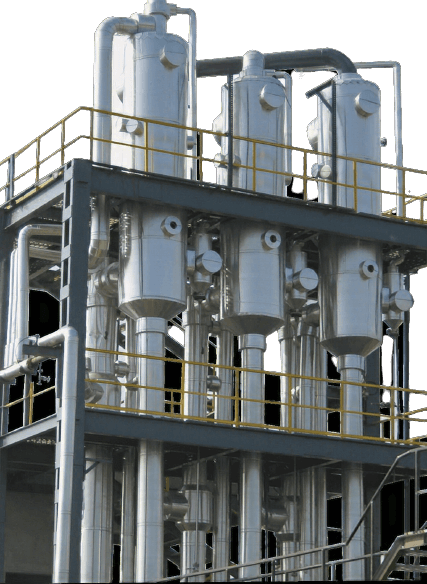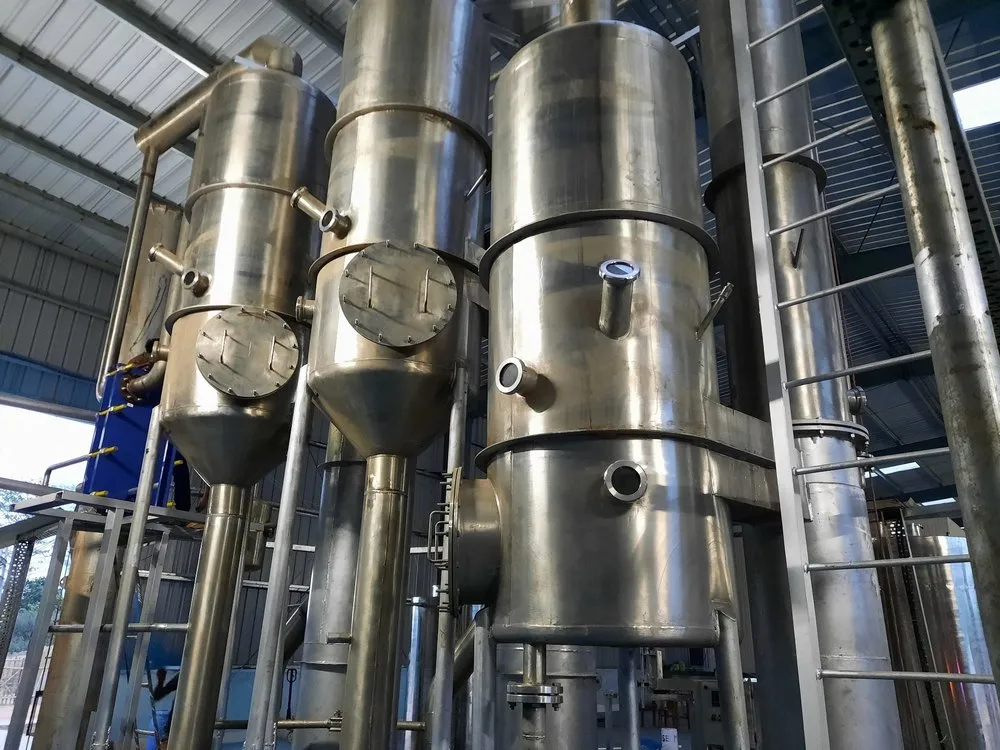Evaporation Systems
"Maximum Uptime, Ease of Operation, Unmathced Performance"
Evaporation systems
Chem Process Systems is an established leader in the supply of process equipment for Vacuum, Evaporation, Crystallization, Drying and Heat Transfer applications. We design, fabricate, erect, commission and test systems, for both process and environmental applications.
Our Wealth of Experience
Chem Process evaporation technology offers a proven solution where the condensates are re-used as make-up water and the recovered crystalline products are recycled for profitable industrial production. We offer complete solutions by combining evaporation with other options of pre and after treatment. Having supplied more than 100 plants in process industries for the treatment of various industrial effluents and concentration of many liquids, the field experience from the design and manufacture along with continued research and development have resulted in a unique expertise in this technology. This enables Chem Process to provide the right combination of other process equipment with the evaporation plants and thus provide practical solutions to the most difficult problems.
Our Wealth of Knowhow
The composition of the effluent may differ extremely, even in the same industries, day to day. Our knowledge of the physical and chemical properties of the intermediates and finished products is both intimate and comprehensive and stems from many years of practical experience. Design is established after taking into consideration the product behavior, optimum operating conditions, evaporator type, concentrated solution and effluent properties.
Evaporation
Evaporation starts with inputs in a liquid form and outputs are more concentrated but still liquids in a pump able state. It is important that the product under evaporation is subject to minimum thermal degradation, hence bespoke design of equipment is mandatory to ensure that the temperature and time of exposure minimal.
These and other important considerations in relation to the physical characteristics of the product to be evaporated have led to the development of many evaporator types. Energy efficiency and environmental concerns, have pioneered novel plant configurations and equipment design - this is precisely the forte of Chem Process Systems; it has designed and provided innovative solutions which today are being followed by others.
Plants for evaporation, distillation, evaporative crystallisation and evaporative drying are energy intensive. Operating costs of these plants are therefore primarily determined by the energy costs.
The reduction and optimisation of the specific energy consumption is therefore of prime importance.
There are three main techniques for minimising specific energy consumption, which can be applied either singly, or in combinations:
- multiple effect or multiple stage arrangement
- thermal vapour recompression
- mechanical vapour recompression
Evaporator Types :
- Falling film
- Natural circulation
- Rising film
- Forced circulation
- Plate type
- Horizontal Wetted Tube
- Combination types
- Thermal vapour compressions, TVR
- Mechanical vapour compression, MVR
Evaporator Applications :
- Product concentration
- Dryer feed pre-concentration
- Volume reduction
- Water/solvent recovery
Combination Type Hybrid Evaporators
Our Combination Type Evaporators are a uniquely designed and engineered systems to provide the solution for certain processes where viscosity and chemical property degradation play a vital role.

These most economic evaporators utilize falling film tubulars or plates, with either thermal vapor recompression (TVR) or mechanical vapor recompression (MVR).
However with many duties, the required concentration of the final product requires a viscosity that is too high for a film evaporator. The solution is to use film evaporation for the pre-concentration and then a forced circulation finisher evaporator to achieve the ultimate concentration; E.g.: a stillage or spent distillery wash evaporator.
The material would typically be concentrated from 4% to 40% in a falling film evaporator and then from 40% to 50% in a forced circulation evaporator. Usually the finisher would be a completely separate evaporator since the finisher’s duty is usually relatively low. In the duty specified above, almost 98% of the evaporation would take place in the high efficiency film evaporator. For cases where the finisher’s load is relatively high, it is possible to incorporate the forced circulation finisher as one of the effects in a multi-effect evaporator. However this is an expensive proposition due to the low coefficients at the high concentration.
Concentration Plants
The use of Fluidic chemicals is on a very high side in the Chemical, Pharmaceuticals, Agro, Fertilizers and almost all segments where there is some reaction based system.
For the ease of operations and handling it becomes must of industrial segments to have minimum space management and higher flexibility in terms of usage at different reactive requirements. For this it is a general practice that industries use powder or solidified chemicals which are diluted or liquefied by adding Water, Solvents or any other fluid / liquid. After the usage the companies would either like to recover the excess water or secondary liquid at certain pre-determined concentrations.
Chem Process is a leader in the manufacture of Concentration plants, whereby we use different thermal and Crystallization technologies individually or in combination to cater to the need of the clients. With more than 100 installations in India and across the globe Chem Process enjoys the matchless position of identifying the chemical reactions, physical and thermal changes and phase identification.With a team of highly qualified Chemical and Mechanical Engineers, Chem Process designs, develops, engineers and manufactures Plants and Equipment for the concentration of different applications.
These fluids can either be any Oil based viscous product, Acids or Alkalis
Chem Process has supplied plants for different applications like
- Sulfuric Acid Concentration
- Amino Acid Concentration
- Nitric Acid Concentration
- Spent Acid Concentration
- Organic Concentration
- NaOH Concentration
- KOH Concentration and many many more

Falling Film Type Evaporator
The Falling Film Evaporators can be operated with a low temperature difference and since the product residence time is very less, they are best suited for liquids which are temperature sensitive, have a high rate of specific heat transfer, particularly for non-crystalline solutions.

Having low liquid holding volumes, the falling film evaporators are very easy to operate, clean and are extremely sturdy, thus the most frequently used types.
Caution must be used to ensure a continuous film wetting rate and to prevent nucleate boiling, otherwise the rate of heat transfer will fall off dramatically, and the rate of fouling on the heat transfer surface will increase.
Types of Evaporators :
- Vapor Induced Film
- Falling Film-tubular & Plate
- Rising Film-tubular & Plate
- Mechanically Induced Film
- Mechanically Agitated Thin Film
Forced Circulation Type Evaporator
Chem Process’ Forced Circulation Evaporators are normally used for liquids which are prone to fouling, scaling, crystallizing or for those which are inversely soluble or while concentrating thermally de-gradable materials. Here high re-circulation rate allows high liquor velocities through the tubes which help to minimize the buildup of deposits or crystals along the heating surface. The universal type, preferably used for concentration of solutions containing encrusting substances, hardening agents and un-dissolved solids, and for viscose solutions; also suitable for evaporative crystallization.
Forced circulation is required when hydrostatic head prevents boiling at the heating surface. A pump can also be used to avoid fouling that is caused by the boiling of liquid on the tubes; the pump suppresses bubble formation. Other problems are that the residing time is undefined and the consumption of steam is very high, but at high temperatures, good circulation is easily achieved.
How it works
Liquid is circulated at a high rate through the heat exchanger, boiling being prevented within the unit by virtue of a hydrostatic head maintained above the top tube plate. As the liquid enters the separator where the absolute pressure is slightly less than in the tube bundle, the liquid flashes to form vapour.

Natural Circulation type Evaporator
Natural Circulation Evaporators are very simple and are normally used where the effluent has a high viscosity, higher levels of hardening agents, un-dissolved solids, for products which are affected by their own high temperatures and longer residual times.

The operation could be continuous, batch or semi-batch and do not require pumps for recirculation or intermediate product transfer. Natural circulation evaporators are based on the natural circulation of the product caused by the density differences that arise from heating.
How It Works
In an evaporator using tubing, after the water begins to boil, bubbles will rise and cause circulation, facilitating the separation of the liquid and the vapor at the top of the heating tubes. The amount of evaporation that takes place depends on the temperature difference between the steam and the solution. Problems can arise if the tubes are not well-immersed in the solution. If this occurs, the system will be dried out and circulation compromised. In order to avoid this, forced circulation can be used by inserting a pump to increase pressure and circulation.
Rising Film Type Evaporator
Chem Process’ Rising Film Evaporators operate on a “Thermo-Siphon” principle. Feed product enters the bottom of the heating tubes and as it heats, steam begins to form. The upward force of this steam produced during the boiling causes liquid and vapors to flow upwards in parallel flow. At the same time the production of vapor increases and the product is pressed as a thin film on the walls of the tubes, and the liquid rises upwards.
This co-current upward movement against gravity has the beneficial effect of creating a high degree of turbulence in the liquid. This is advantageous during evaporation of highly viscous products and products that have a tendency to foul the heating surfaces.
Usually there must be a rather high temperature difference between the heating and boiling sides of this type of evaporator. Otherwise the energy of the vapor flow is not sufficient to convey the liquid and to produce the rising film.

Single and Multi Stage Flash type Evaporator
Energy efficiency of Chem Process Evaporators and Crystallizers is a crucial consideration during the designing of each customer’s specific application. Energy efficient systems utilize waste heat, multiple effects, mechanical vapor recompression (MVR) and/or thermal vapor recompression (TVR).
The evaporation duty is separated into stages operating at different temperatures. External heat drives the first effect of the evaporator, with subsequent effects being driven by vapor generated from the previous higher temperature effect. Product may be passed through the evaporator in forward, back or mixed flow configurations. Additional efficiency is achieved with the use of regenerative heaters, condensate heaters and vapor heaters.

